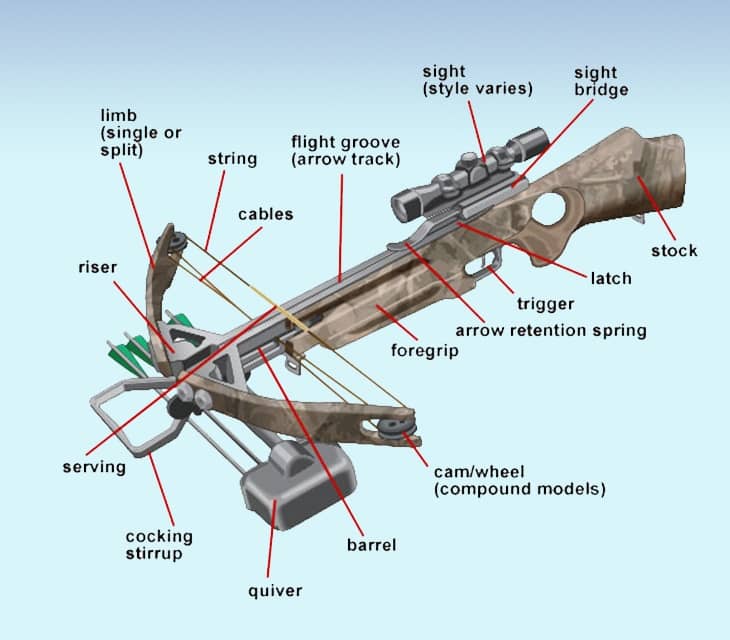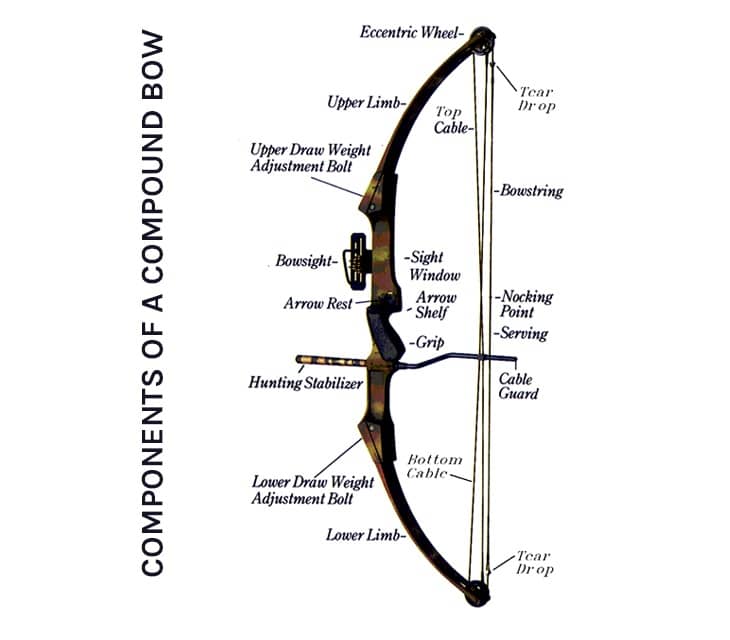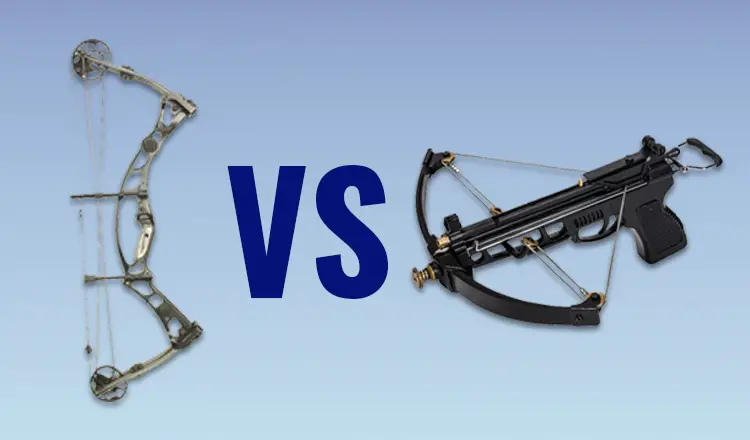Although there’s some distance between the emergence of crossbows and compound bows, the debate about which one works better is still in the air.
Both have their bright and dark sides. So, both have followers and critics.
In fact, a crossbow isn’t any good or bad than a compound bow. It’s just a matter of your preferences. A compound bow may not work where a crossbow performs best. The same may happen to a crossbow.
So, what should you get, who’s the winner of the “crossbows vs compound bows” debate?
Crossbows and compound bows differ in many aspects including components, draw weight, power stroke, performance, energy, and speed.
The main difference, however, lies in usability and range. Crossbows allow multiple quick shots with great accuracy over a short distance, whereas compound bows are all about precision over a long range.
In this article, I’ve presented you with a comparative and contrasting study on both bows to help you get along with the right crossbow or an advanced compound bow.
Crossbows vs Compound Bows: Which One to Choose
You might be wondering which bow is better for getting an excellent day out in the wilderness.
A hunting enthusiast would carry out thorough research before deciding to choose a bow. We have this part covered for you.
Read the following discussion to get an in-depth insight into the contrast and comparison of Crossbows vs Compound Bows.
Introduction to the Components
Both bows are designed with particular components that contribute to their design, accuracy, speed, durability, and overall performance.
But these bows differ much as you look at their components which are not very similar to each other.
A crossbow consists of a riser, stock, Sight Bridge, limbs, latch, flight groove, cocking stirrup, barrel, and arrow retention spring mainly.
A compound bow consists of a riser, limbs, cams, cam systems, bowstring, cables, cable guard, cable slide, arrow rest, peep sight, sight, string vibration arrester, and a stabilizer.
Components of a Crossbow
Each element of a bow serves a distinctive purpose. There are two common types of crossbows – the compound crossbow and recurve crossbow.
Most of the components are the same in both bows having a subtle difference. The basic parts of a crossbow are as follows.

- The Barrel (Known as the “rail” or the “track” and made of plastic, it connects the bow to the stock of a crossbow.)
- The Riser (The riser is the connecting point of the two limbs. A riser is usually made from magnesium and aluminum, and carbon fiber.)
- The Foot Stirrup (The cocking stirrup is located right at the end of the riser and helps the hunter cock the crossbow.)
- The Trigger and Safety (A trigger determines the shooting time of your bow. The more weight the trigger incorporates, the more speed the arrow will gain.)
- The Stock (The stock works as a parental body. It toes the sight bridge, barrel, and the trigger mechanism altogether. It allows the archer to hold the bow without touching other sensitive parts.)
- Sight Bridge (It helps the archer get the perfect shot right at the heart of the target. This is the part where your sight will have a solid base to aim at the target.)
- Arrow Retention Spring (This spring holds the arrow in track until the archer intends to release the arrow. Two types of materials include steel springs (the noisier) and plastic springs (the quieter).)
- Latch (A latch captures the string until the trigger is pulled. As you cock the crossbow, the latch holds the string in place. After you pull the trigger, the latch releases the string allowing the arrow to travel freely.)
- Limbs (Limbs are the extended part of the bow holding the string at the marginal part of the extension. They’re important since the speed and force of the arrows mostly depend on the length of the limbs.)
Components of a Compound Bow
A compound bow runs conforming to a more complex mechanism. There are a few moving parts involved unlike other types of bows.
If you are a newbie in the realm of archery, be watchful while using a compound crossbow. You will be able to increase your accuracy with time by following some effective archery tips.
Let’s get a walkthrough of the components of a compound bow.

- Riser (Made of aluminum or carbon fiber and located in the center, the riser contains the grip, and attached to it are a few components such as the arrow shelf, sight, quiver, and stabilizer.)
- Limbs (Looking like a fiberglass plank, limbs easily flex and bend contain due to their fiberglass properties. Two types of limbs are solid and split limbs.)
- Cams (Each limb has an oval-shaped/round disk mounted to its end. These are the cams, the most significant indicator that differentiates a compound bow from a crossbow.)
- Bowstring (Bowstrings are critical to a bow’s usability. These strings help the arrow gain strength and speed and, then, send the arrow toward the target.)
- Cables (Cables work simultaneously with the cams to help archers improve their accuracy. The cams being associated with the cables adjust the firing power keep to reinforce the crossbow.)
- Arrow Rest (This is where you rest your arrow before releasing it. Containment arrow rest is the most commonly used variant of arrow rest.)
- Peep Sight (Mounted between the bowstring, the peep sight is a piece of plastic having the shape of a circle. After pulling the string back, one can look through it, spot and track the target.)
- Sight (Attached to the riser, the sight of a bow is almost similar to that of a gun and helps the archer aim his/her bow perfectly. It has 3-5 pins in the sight circle set for aiming at a specific distance.)
- String Vibration Arrester (Tethered to the riser and close to the bowstring, this component helps reduce the noise of the bow absorbing the vibration during the shot.)
- Stabilizer (This is an optional piece to enhance your hunting experience. It’s a small rod designed to reduce vibration and noise and help the user keep the weapon steady while shooting.)
Performance
Factors that matter most in archery include speed, draw and (draw) weight, noise, size, mass weight, and accuracy.
All these factors determine the quality of a bow. Crossbows and compound bows also differ from each other in terms of these factors.
Energy and Speed
The energy and speed of a bow depending on the draw weight and the power stroke.
If you want to get the maximum speed and energy from your bows, you have to shoot the arrow after reaching to the highest draw weight and pull the string to such a point so that the distance equals the power stroke.
The combination of perfect draw weight and draw length can produce the best energy and speed for both compounds and crossbows.
Draw Weight
A bow needs a minimum weight to be drawn flawlessly. Less draw weight will cause the bow to shoot the arrows at a low speed.
You should apply the maximum amount of force to reach the maximum draw weight because a bow becomes fully drawn only if the draw weight hits the optimum mark.
Crossbows yield more draw weight. With shorter power strokes, they generate more speed than compound bows.
Power Stroke
You have to pull the string of the bow to a certain distance to store energy.
Power stroke refers to the distance a bowstring travels between the full draw and rest position. The longer the power stroke, the faster the arrow will fly.
The draw length of a compound bow is easy to lengthen whereas it’s difficult to lengthen the draw length of a crossbow. So, a compound bow is the better of the two in this regard.
A Fresh Look at the Compound bow vs Crossbow Debate
Excess poundage of a crossbow allows it to shoot faster arrows, but that positive side is associated with a negative effect.
Using a crossbow often is troublesome for the high poundage and weak and injured people face difficulty while shooting with a crossbow.
Besides, it needs more time to draw, lock and shoot. This isn’t convenient for a hunting enthusiast. You have to do it really quickly in a wild environment.
In terms of usability, I take the compound bow as a winner.
Size and Weight
Crossbows are a bit smaller than compound bows. Though compound bows are large in size, they are not cumbersome to carry through the woods.
Crossbows can’t do much good to a hunter being shorter than compound bows because they are heavy and hard to deal with in outdoor situations.
Due to this excessive weight, people tend to use compound bows for hunting situations.
Noise and Vibration
A crossbow creates more sound than a compound bow because the crossbows have high poundage and a manual mechanism that causes more vibration and sound.
A compound bow is a relatively new invention with an advanced shooting mechanism compromising cams, cables, string vibration arresters, stabilizers, etc.
These few parts all together ensure that the compound produces little vibration and noise. A bow that produces the least vibration and noise is the one you want while in the wood.
Accuracy
A compound bow can give you great accuracy. It has a constant anchor point and a more developed mechanism to back the accuracy feature.
The crossbows have a latch that holds the string until you pull off the trigger.
But in this case, the consistent string position gets compromised sometimes. As a result, you will get less accuracy compared to that of a compound bow.
Price
The price of the bows depends on the built quality, material, usability, and brand of the bows. I recommend my friends and readers to look for a bow (both crossbow and compound) that comes at a midrange budget. I don’t recommend spending a lot of bucks on the bow.
Legal Obligations
Crossbows and compound bows both have some legal obligations to conform to. The user must be above 14 years old and have a license to use bows for hunting.
You shouldn’t enter private property without the permission of the landowner. You shouldn’t shoot with crossbows within 250 meters of any home, school, playground, etc.
Some states allow a crossbow only in archery season. Most of the states of the USA allow compound bows.

Only two states, Montana and South Dakota State don’t allow a compound bow any less than 28 inches as measured from top to bottom.
So, you can easily take part in any kind of hunting keeping these rules and regulations in mind. Know the rules and regulations of your hunting place before it entraps you in trouble.
Maintenance and Durability
Regardless of the type of bow, you have to maintain the bow to get the most out of it. A bow will not last long without proper maintenance.
Crossbows are prone to damage. The strings, cables and other parts often need to be replaced and repaired. On the contrary, the best compound bow hardly needs any replacement or repair.
Crossbow and compound bows will not last any longer than two years if you leave them with little/without care.
The following maintenance tips will keep your bows in a good shape for a prolonged period while delivering accuracy.
- Figure out the exact draw weight and draw length that fit your bow.
- Inspect the bow after and before every shot. Check the riser, handle, safety, bowstring, etc. sensitive parts.
- Store the bow properly. Clean the bows and keep them in a dedicated case if possible.
- If you aren’t an expert, consult an expert for an annual inspection.
- Never dry fire your bow. Firing the bow without an arrow or bolt puts all the pressure and tension on the string and may damage it.
- Choose a compatible bow as per your strength, style, and body structure.
So, crossbow vs compound bow, who wins? Again this question! I can’t answer it directly.
Moreover, I shouldn’t, without knowing your archery skills, and age. The above discussion should help you.
However, I’m also available for helping you with any questions regarding this topic. Happy bow hunting!
FAQs
What Is an Advantage of Hunting With a Crossbow?
It’s hard to pin down any single advantage of crossbow hunting. The game offers economic, therapeutic, and recreational benefits, alongside providing a great experience.
What Sets a Crossbow Apart From Other Bows?
Among all the bow-hunting types, crossbows provide the maximum amount of power and stability over each stroke. It also offers quick mechanical reloads so you don’t easily miss your opportunities.
Are Crossbows More Powerful Than Compound Bows?
Yes! A typical crossbow delivers around 30 fps of more speed and 30 ft-lbs of more kinetic energy (on average) than a standard compound bow. However, there are still some compound bows more powerful than crossbows.
What Shoots Farther, a Crossbow or Compound Bow?
A compound bow will win this race. When shot, an arrow from a compound bow will cover almost twice the distance a crossbow arrow will cover.








Leave a Comment